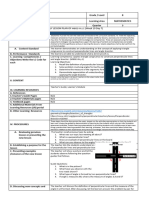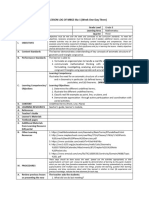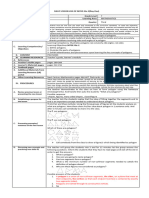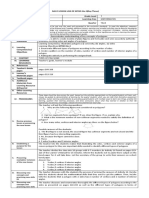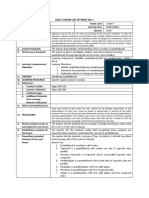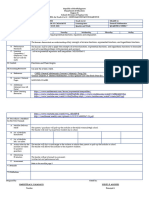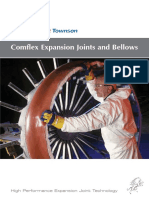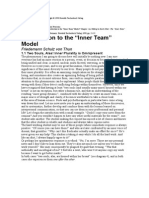0 ratings0% found this document useful (0 votes)
7K viewsIII-Day 4
III-Day 4
Uploaded by
Johnpaul Camazo1. The document summarizes a mathematics teacher's daily lesson log for an 8th grade geometry lesson on defined terms.
2. The lesson objectives were for students to understand key concepts of axiomatic structure and triangle congruence. Students determined different defined terms like collinear, coplanar, rays, and line segments through examples and illustrations.
3. Formative assessment questions evaluated students' understanding of concepts like collinear points, intersection of lines and planes, and representations of rays and line segments. The teacher reflected on students' progress and strategies for improvement.
Copyright:
© All Rights Reserved
Available Formats
Download as DOCX, PDF, TXT or read online from Scribd
III-Day 4
III-Day 4
Uploaded by
Johnpaul Camazo0 ratings0% found this document useful (0 votes)
7K views3 pages1. The document summarizes a mathematics teacher's daily lesson log for an 8th grade geometry lesson on defined terms.
2. The lesson objectives were for students to understand key concepts of axiomatic structure and triangle congruence. Students determined different defined terms like collinear, coplanar, rays, and line segments through examples and illustrations.
3. Formative assessment questions evaluated students' understanding of concepts like collinear points, intersection of lines and planes, and representations of rays and line segments. The teacher reflected on students' progress and strategies for improvement.
Original Description:
math 8
Copyright
© © All Rights Reserved
Available Formats
DOCX, PDF, TXT or read online from Scribd
Share this document
Did you find this document useful?
Is this content inappropriate?
1. The document summarizes a mathematics teacher's daily lesson log for an 8th grade geometry lesson on defined terms.
2. The lesson objectives were for students to understand key concepts of axiomatic structure and triangle congruence. Students determined different defined terms like collinear, coplanar, rays, and line segments through examples and illustrations.
3. Formative assessment questions evaluated students' understanding of concepts like collinear points, intersection of lines and planes, and representations of rays and line segments. The teacher reflected on students' progress and strategies for improvement.
Copyright:
© All Rights Reserved
Available Formats
Download as DOCX, PDF, TXT or read online from Scribd
Download as docx, pdf, or txt
0 ratings0% found this document useful (0 votes)
7K views3 pagesIII-Day 4
III-Day 4
Uploaded by
Johnpaul Camazo1. The document summarizes a mathematics teacher's daily lesson log for an 8th grade geometry lesson on defined terms.
2. The lesson objectives were for students to understand key concepts of axiomatic structure and triangle congruence. Students determined different defined terms like collinear, coplanar, rays, and line segments through examples and illustrations.
3. Formative assessment questions evaluated students' understanding of concepts like collinear points, intersection of lines and planes, and representations of rays and line segments. The teacher reflected on students' progress and strategies for improvement.
Copyright:
© All Rights Reserved
Available Formats
Download as DOCX, PDF, TXT or read online from Scribd
Download as docx, pdf, or txt
You are on page 1of 3
DAILY LESSON LOG OF M8GE-IIIa-1 (Week One-Day Four)
School Grade Level Grade 8
Teacher Learning Area Mathematics
Teaching Date and Time Quarter Third
Objectives must be met over the week and connected to the curriculum standards. To meet the
objectives, necessary procedures must be followed and if needed, additional lessons, exercises and
remedial activities may be done for developing content knowledge and competencies. These are
I. OBJECTIVES assessed using Formative Assessment Strategies. Valuing objectives support the learning of content and
competencies and enable children to find significance and joy in learning the lessons. Weekly objectives
shall be derived from the curriculum guides.
A. Content Standards The learner demonstrates understanding of key concepts of axiomatic structure of
geometry and triangle congruence.
B. Performance Standards The learner is able to:
1. formulate an organized plan to handle a real-life situation, and
2. communicate mathematical thinking with coherence and clarity in
formulating, investigating, analyzing, and solving real-life problems involving
congruent triangles using appropriate and accurate representations.
Learning Competency:
Illustrates the need for an axiomatic structure of a mathematical system in general,
and in Geometry in particular: (a) defined terms; (b) undefined terms; (c)
postulates; and (d) theorems.. (M8GE-IIIa-c-1)
C. Learning Competencies/
Learning Objectives:
Objectives
1. Determine the different defined terms;
2. Illustrate defined terms; and
3. Demonstrate appreciation through active participation and coordination with
varied activities.
II.CONTENT Defined terms (Coplanar, Colinear, Rays, Line Segements, Intersections)
III.
LEARNING RESOURCES teacher’s guide, learner’s module,
A. References
1. Teacher’s Guide
2. Learner’s Materials
3. Textbook pages
4. Additional Materials
from Learning Resource
(LR) portal
B. Other Learning 1. https://studylib.net/doc/5634825/sec-1-1-points--lines-and-planes
Resources 2. http://ww2.d155.org/pr/acadirectory/math/Lists/Geometry
%20357358%20Calendar/Attachments/87/Chapter%201%20Note
%20Packet.doc
These steps should be done across the week. Spread out the activities appropriately so that
pupils/students will learn well. Always be guided by demonstration of learning by the pupils/ students
which you can infer from formative assessment activities. Sustain learning systematically by providing
IV. PROCEDURES pupils/students with multiple ways to learn new things, practice the learning, question their learning
processes, and draw conclusions about what they learned in relation to their life experiences and
previous knowledge. Indicate the time allotment for each step.
The teacher asks the students:
1. What did we do last meeting?
A. Review previous lesson 2. What are the different undefined terms?
or presenting the new
lesson Questions:
1. We determined the three undefined terms.
2. These are points, line and plane.
B. Establishing a purpose The teacher lets the students realize the importance of the different defined terms
for the lesson in geometry.
The teacher asks the students to do the following:
1. Get 1/4 sheet of paper, what does the paper represents?
2. How many lines are there in your 1/4 sheet of paper, how do these lines
relate to each other?
C. Presenting examples/ 3. Plot three points in a 1/4 sheet of paper, how are these points relate to each
instances of the new other?
lesson 4. Plot points on the same line, how do these points relate to each other?
5. Fold the paper in half and shade the other with a pen/pencil, what does the
crease of the paper represents?
6. Put a puncture on the paper using your pen/pencil, what does that puncture
represents?
The teacher lets the students realize that what they did are:
1. Plane = The paper is an example of a plane.
2. Coplanar lines = The lines are on the same plane.
D. Discussing new concepts 3. Coplanar points = the paper is a plane where the three points named are
and practicing new skills #1 contained.
4. Colinear points = the points are all contained in the same line.
5. Intersection of two planes is a line.
6. The intersection of the plane and a line is a point.
The teacher discusses and illustrates the definitions and some of the examples of
the following:
E. Discussing new concepts 1. Collinear points/lines and Non-collinear points/lines.
and practicing new skills #2 2. Coplanar points/lines and Non-coplanar points/lines.
3. Rays and Line Segments
4. Intersection of a line and a point, two lines, a line and a plane.
Working in pairs, the students will illustrate the following.
a. Draw 3 collinear points A, B, C.
b. Draw point D not collinear with ABC.
F. Developing mastery (leads c. Draw .
to formative assessment 3)
d. Draw ray .
e. Draw segment .
f. Name opposite rays.
What could be the best representation of ray and line segments in the classroom.
Rays: pens, pencil, crayons, or anything that writes.
G. Finding practical Line segments:window pane, edge of a table.
applications of concepts
and skills in daily living Note:
Rays extends in one side and with pencil, as it writes, it extends.
Line segments has an ending point, thus have a limit.
H. Making generalizations
The teacher lets the students summarize the topic by asking the following:
and abstractions about the
lesson
1. What are the
I. Evaluating Learning The teacher lets the students answer individually the
formative assessment.
I. Answer True or False for the following:
a) Points A, B, and C are collinear.
b) Points A, B, and C are coplanar.
c) Point F lies on .
d) lies on plane DEF.
e) and intersect.
f) is the intersection of plane ABC and plane DEF.
Answer Key:
I. a. False; b. true; c. False; d. false; e. True; f. False
J. Additional activities or
remediation
V. REMARKS
Reflect on your teaching and assess yourself as a teacher. Think about your students’ progress. What
works? What else needs to be done to help the pupils/students learn? Identify what help your
VI. REFLECTION instructional supervisors can provide for you so when you meet them, you can ask them relevant
questions.
A. No. of learners who
earned 80% of the
evaluation
B. No. of learners who
require additional
activities for
remediation who scored
below 80%
C. Did the remedial lesson
work? No. of learners
who have caught up
with the lesson.
D. No. of learners who
continue to require
remediation
E. Which of my teaching
strategies worked well?
Why did these work?
F. What difficulties did I
encounter which my
principal or supervisor
can help me solve?
G. What innovation or
localized materials did I
The teacher contextualized and localized the concept of the topic in “presentation”
use/ discover which I
and “finding practical application”.
wish to share with other
teachers
Prepared by:
MARISTELA M. CALASANG
Teacher
You might also like
- OPERATIONS STRATEGY - AMERICAN CONNECTOR OsDocument12 pagesOPERATIONS STRATEGY - AMERICAN CONNECTOR OsNithya NairNo ratings yet
- Survey of Resonant Converter Topologies PDFDocument26 pagesSurvey of Resonant Converter Topologies PDFVIVEK THOMAS CHACKONo ratings yet
- Daily Lesson Log of M8Ge-Iiia-1 (Week One-Day Four) : QuestionsDocument3 pagesDaily Lesson Log of M8Ge-Iiia-1 (Week One-Day Four) : QuestionsFlorita Lagrama100% (2)
- III-Day 5Document2 pagesIII-Day 5Rainman InsanityNo ratings yet
- Iii-Day 2Document3 pagesIii-Day 2alexpica0404No ratings yet
- DLL With AnnotationsDocument6 pagesDLL With AnnotationsmaryelsiejoyjNo ratings yet
- III-Day 3Document5 pagesIII-Day 3Polix Abule Jr.No ratings yet
- III-Day 25Document3 pagesIII-Day 25Myckhaell Jhon Xyrille C. AgcanasNo ratings yet
- Daily Lesson Log of M7Ge-Iiig-1 (Week Seven-Day One)Document3 pagesDaily Lesson Log of M7Ge-Iiig-1 (Week Seven-Day One)Zile SmithNo ratings yet
- Demo DLLDocument4 pagesDemo DLLJOHN ALFRED MANANGGITNo ratings yet
- III-Day 39Document3 pagesIII-Day 39Rainman InsanityNo ratings yet
- Consolidated DLP For Grade 9 3rd QuarterDocument86 pagesConsolidated DLP For Grade 9 3rd Quarterricel jean panganNo ratings yet
- Math 7 - Cot 1Document2 pagesMath 7 - Cot 1MARY VINA FERRERNo ratings yet
- Iii-Day 2Document3 pagesIii-Day 2jack macabatalNo ratings yet
- Q2 Week 5 Math 8Document10 pagesQ2 Week 5 Math 8jenny magdaongNo ratings yet
- DLL Output 1 - WEEK 1, DAY 1Document4 pagesDLL Output 1 - WEEK 1, DAY 1Merlyn Del Rosario DeitaNo ratings yet
- Geometry G7 Lesson Iii-Day 7Document9 pagesGeometry G7 Lesson Iii-Day 7ROSEMARIE SANTOSNo ratings yet
- III-Day 3Document6 pagesIII-Day 3Johnpaul CamazoNo ratings yet
- III-Day 3Document6 pagesIII-Day 3Rainman Insanity100% (1)
- Iii-Day 18Document6 pagesIii-Day 18PERATER, JELLY A.No ratings yet
- DAILY LESSON LOG OF M8AL-Ig-1 (Week Seven-Day One) : Possible ResponsesDocument3 pagesDAILY LESSON LOG OF M8AL-Ig-1 (Week Seven-Day One) : Possible ResponsesFlorita Lagrama100% (2)
- IV-Day 26Document4 pagesIV-Day 26Robin LayugNo ratings yet
- Local Media7422673667167838373Document6 pagesLocal Media7422673667167838373Mosnaira GuiapsonNo ratings yet
- Lesson in Planning GRADE 8Document4 pagesLesson in Planning GRADE 8John Carlo Leoperes MedoraNo ratings yet
- DLL Math7 Q3 W1S1Document7 pagesDLL Math7 Q3 W1S1Ruelan ImpasNo ratings yet
- III Quarter-Math 7 DLLDocument6 pagesIII Quarter-Math 7 DLLKM Laysa GonzalesNo ratings yet
- II-Day 14Document4 pagesII-Day 14JESSA LOU CAPAPASNo ratings yet
- I-Day 28Document2 pagesI-Day 28EDITHA PAGUYONo ratings yet
- Cot DLL BrendaminDocument4 pagesCot DLL BrendaminNyl Rej FernandezNo ratings yet
- Lesson Plan Feb. 22Document4 pagesLesson Plan Feb. 22Sindaw Youth Association for ProgressNo ratings yet
- Co2 - MathDocument5 pagesCo2 - MathHazel CandaNo ratings yet
- Figures and Shapes Math LP FinalDocument10 pagesFigures and Shapes Math LP FinalKyle De Jesus PacanjiNo ratings yet
- M7Ge Iiid E 1Document2 pagesM7Ge Iiid E 1NoreenNo ratings yet
- III-Day 40Document3 pagesIII-Day 40Rainman InsanityNo ratings yet
- I-Day 13Document3 pagesI-Day 13Ma. Esperanza VenturaNo ratings yet
- Republic of The Philippines Department of Education: Manaul National High School Rodner Jr. L. Fruelda February 13, 2023Document3 pagesRepublic of The Philippines Department of Education: Manaul National High School Rodner Jr. L. Fruelda February 13, 2023Lloyd Francis CarillaNo ratings yet
- Lesson Plan in Math 7 (Q3W1-Day 1)Document6 pagesLesson Plan in Math 7 (Q3W1-Day 1)Jerry BasayNo ratings yet
- III-Day 2Document3 pagesIII-Day 2Daimon DanteNo ratings yet
- III Quarter-Math 7 DLLDocument2 pagesIII Quarter-Math 7 DLLKM Laysa Gonzales100% (1)
- Illustrates Triangle CongruentDocument7 pagesIllustrates Triangle CongruentAngelyn LluviosoNo ratings yet
- Q2 Week 1 Math 8Document12 pagesQ2 Week 1 Math 8jenny magdaongNo ratings yet
- March 14, 2023Document3 pagesMarch 14, 2023Christian Elim SoliganNo ratings yet
- Co1 2023 RevisedDocument5 pagesCo1 2023 Revisedchenna.saulong16No ratings yet
- Lesson Plan FBS - 05 09 2023Document4 pagesLesson Plan FBS - 05 09 2023Joyce EdemNo ratings yet
- LE - G11 WEEK1 Pre CalculusDocument6 pagesLE - G11 WEEK1 Pre CalculusCgc Bryan Del PilarNo ratings yet
- LP Mon W6 Math G5Document6 pagesLP Mon W6 Math G5EDICHEL ALBAONo ratings yet
- LP7Document4 pagesLP7Jayvee R RosopaNo ratings yet
- III-Day 5Document3 pagesIII-Day 5Polix Abule Jr.No ratings yet
- DLL Precalculus Week 1Document3 pagesDLL Precalculus Week 1Elswhere Cu PidNo ratings yet
- DAILY LESSON LOG OF STEM - PC11AG-Ia-5 (Week One-Day Four)Document3 pagesDAILY LESSON LOG OF STEM - PC11AG-Ia-5 (Week One-Day Four)PETER JOHN BACANINo ratings yet
- (M10Ge-Iic-D-1) : Minuyan National High School Grade 10 Jefferson B. Torres Mathematics October 25, 2024 SecondDocument3 pages(M10Ge-Iic-D-1) : Minuyan National High School Grade 10 Jefferson B. Torres Mathematics October 25, 2024 SecondJefferson TorresNo ratings yet
- DLL March 9Document2 pagesDLL March 9Paynor MenchNo ratings yet
- III-Day 1Document3 pagesIII-Day 1Daimon DanteNo ratings yet
- Math Week 4Document20 pagesMath Week 4LizaNo ratings yet
- Grade 9 - Theorem On Special Parallelograms (Rectangle, Rhombus, Square)Document2 pagesGrade 9 - Theorem On Special Parallelograms (Rectangle, Rhombus, Square)JONATHAN IAN UBASNo ratings yet
- Additional Materials From Learning Resource (LR) PortalDocument2 pagesAdditional Materials From Learning Resource (LR) PortalClemence Enree OcampoNo ratings yet
- Republic of The Philippines Department of Education: Manaul National High School Rodner Jr. L. Fruelda February 16, 2023Document3 pagesRepublic of The Philippines Department of Education: Manaul National High School Rodner Jr. L. Fruelda February 16, 2023Lloyd Francis CarillaNo ratings yet
- DLL Grade 7 Q3-Week 5-8Document14 pagesDLL Grade 7 Q3-Week 5-8Angela Camille PaynanteNo ratings yet
- Math 8 NewDocument6 pagesMath 8 NewDj TayoneNo ratings yet
- DLL 9 - Week 6 Q3Document2 pagesDLL 9 - Week 6 Q3bernadeth villanueva100% (1)
- I-Day 31Document3 pagesI-Day 31Florita LagramaNo ratings yet
- Powerpoint Css 11Document13 pagesPowerpoint Css 11Johnpaul CamazoNo ratings yet
- 2019 G8 Daily Lesson Log Q2Document11 pages2019 G8 Daily Lesson Log Q2Johnpaul CamazoNo ratings yet
- Sept 5,2022Document37 pagesSept 5,2022Johnpaul CamazoNo ratings yet
- PT - Mapeh 7 - Q1Document5 pagesPT - Mapeh 7 - Q1Johnpaul CamazoNo ratings yet
- Daily Lesson Log in Housekeeping Grade 9Document4 pagesDaily Lesson Log in Housekeeping Grade 9Johnpaul CamazoNo ratings yet
- HousekeepingDocument28 pagesHousekeepingJohnpaul CamazoNo ratings yet
- Week 7Document2 pagesWeek 7Johnpaul CamazoNo ratings yet
- Week 4Document2 pagesWeek 4Johnpaul CamazoNo ratings yet
- G8 Daily Lesson Log Q1Document10 pagesG8 Daily Lesson Log Q1Johnpaul CamazoNo ratings yet
- Table of SpecificationDocument3 pagesTable of SpecificationJohnpaul CamazoNo ratings yet
- PT G7 MapehDocument4 pagesPT G7 MapehJohnpaul CamazoNo ratings yet
- Week IDocument2 pagesWeek IJohnpaul CamazoNo ratings yet
- Week 7Document2 pagesWeek 7Johnpaul CamazoNo ratings yet
- Week IDocument2 pagesWeek IJohnpaul CamazoNo ratings yet
- Week 5Document2 pagesWeek 5Johnpaul CamazoNo ratings yet
- Week 2Document2 pagesWeek 2Johnpaul CamazoNo ratings yet
- Week 4Document2 pagesWeek 4Johnpaul CamazoNo ratings yet
- Week 6Document2 pagesWeek 6Johnpaul CamazoNo ratings yet
- Week 3Document2 pagesWeek 3Johnpaul CamazoNo ratings yet
- III-Day 3Document6 pagesIII-Day 3Johnpaul CamazoNo ratings yet
- Thendral Vanthu Theendum Pothu Song Lyrics-Avatharam PDFDocument1 pageThendral Vanthu Theendum Pothu Song Lyrics-Avatharam PDFp eajeshNo ratings yet
- Vologzhanina Resume ADocument1 pageVologzhanina Resume Aapi-309047901No ratings yet
- Macsteel VRN VRN 200 DatasheetDocument1 pageMacsteel VRN VRN 200 DatasheetIgor NhamanoNo ratings yet
- JW Comflex Expansion Joints Bellows PDFDocument24 pagesJW Comflex Expansion Joints Bellows PDFidrisNo ratings yet
- Customer Satisfaction in Maruti SuzukiDocument31 pagesCustomer Satisfaction in Maruti Suzukirajesh laddha100% (1)
- RPSL Data Jan 2020Document66 pagesRPSL Data Jan 2020Sahitya RoyNo ratings yet
- AssingmentDocument2 pagesAssingmentesmailkarimi456No ratings yet
- HM 11Document51 pagesHM 11body fayezNo ratings yet
- VariogramsDocument20 pagesVariogramsBuiNgocHieu92% (13)
- My ESAS - Workflow - RequestDocument1 pageMy ESAS - Workflow - RequestIlove music096No ratings yet
- L8 G8 Reflection of LightDocument7 pagesL8 G8 Reflection of LightDina ThebianNo ratings yet
- Formation Evaluation: Geophysics For Petroleum EngineersDocument19 pagesFormation Evaluation: Geophysics For Petroleum EngineersMustafa AkyolNo ratings yet
- Use of Hand Tools: DescriptionDocument14 pagesUse of Hand Tools: DescriptionTawhid100% (1)
- Optimization of Distribution SystemDocument6 pagesOptimization of Distribution SystemІван ГладьNo ratings yet
- SNM800 Sounder Notification Module - Installation InstructionsDocument8 pagesSNM800 Sounder Notification Module - Installation Instructionsalberto raposo mateoNo ratings yet
- University of Cambridge International Examinations General Certificate of Education Advanced LevelDocument8 pagesUniversity of Cambridge International Examinations General Certificate of Education Advanced LevelPelatihan MatematikaNo ratings yet
- LESSON PLAN 3 Inspectie 2015Document4 pagesLESSON PLAN 3 Inspectie 2015Stefan PodinaNo ratings yet
- 8-Bit Microcontroller With 64K Bytes In-System Programmable Flash Atmega64ADocument21 pages8-Bit Microcontroller With 64K Bytes In-System Programmable Flash Atmega64AwafelijzerNo ratings yet
- ExperiencerDocument4 pagesExperiencerAlmirante Gilberto JoséNo ratings yet
- Schulz Von ThunDocument1 pageSchulz Von ThunMarco Antonio Wong MorenoNo ratings yet
- Continuous Process Improvement (CPI)Document4 pagesContinuous Process Improvement (CPI)abebaw matebuNo ratings yet
- Haulotte Optimum 8Document2 pagesHaulotte Optimum 8dany dayNo ratings yet
- Octavo Por Un CuartoDocument1 pageOctavo Por Un CuartoJulians PrietoNo ratings yet
- Cambridge IGCSE Mathematics Core and Extended Workbook by Ric Pimentel, Terry Wall PDFDocument97 pagesCambridge IGCSE Mathematics Core and Extended Workbook by Ric Pimentel, Terry Wall PDFPrince Yug89% (27)
- Atersa Photovoltaic Module A-140pDocument16 pagesAtersa Photovoltaic Module A-140pAaron BrozovichNo ratings yet
- Hamilton Et Al 2021. The Future... TaxonomyDocument2 pagesHamilton Et Al 2021. The Future... TaxonomylucindaNo ratings yet
- Professor Jayashankar Telangana State Agricultural University Agricultural College Warangal Challenging TaskDocument19 pagesProfessor Jayashankar Telangana State Agricultural University Agricultural College Warangal Challenging TaskManisha NerellaNo ratings yet
- Table Besi IwfDocument1 pageTable Besi IwfRusdi AnankNo ratings yet











